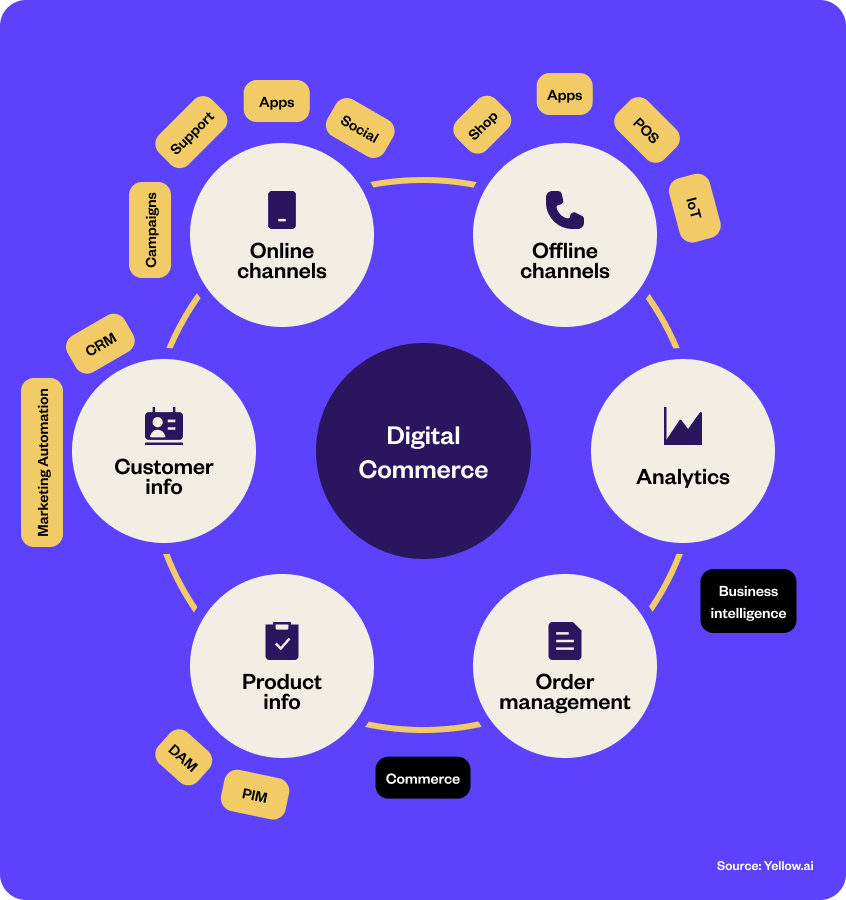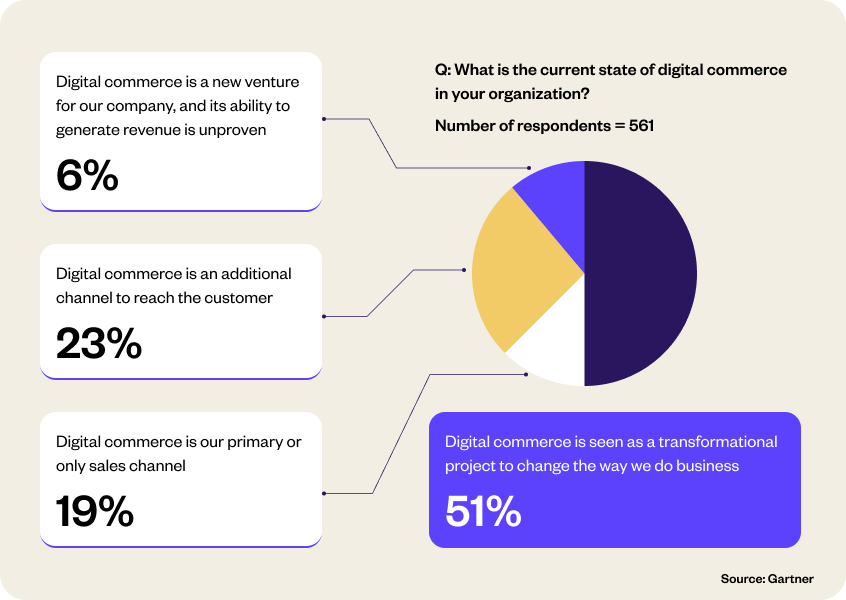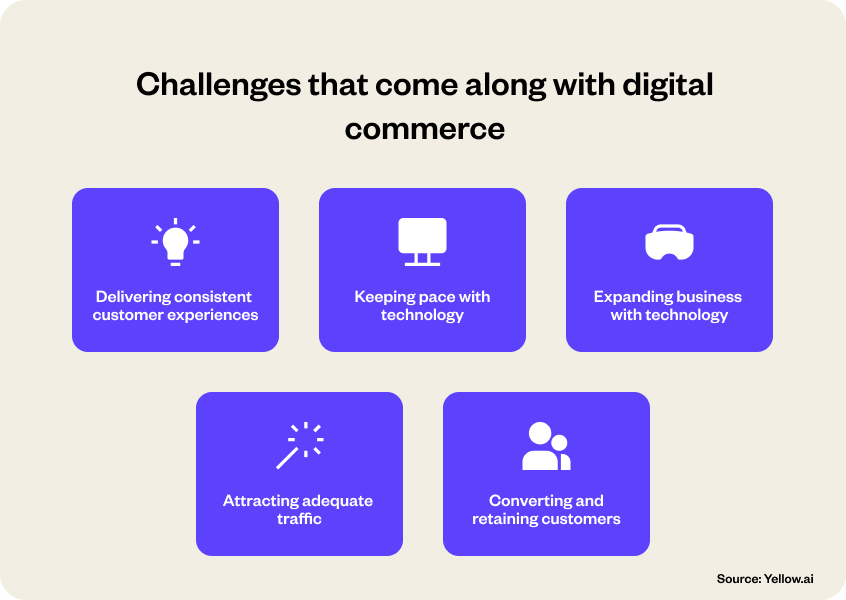Running a successful online business is no less than a bumpy ride to success. About a decade ago businesses could flourish with a website and an elementary supply chain model, but today they can’t even set their foot in the marketplace with this strategy. However, every problem comes with a greater opportunity, and businesses can grab it and rise above the competition. Digital commerce is the solution to open new gates of success and thrive in the various business sectors.
In this era of the experience economy, simple e-commerce operations won’t cut the chase and meet the expectations of modern-day customers. Businesses need to provide an impeccable experience from click to courier. They should understand the customers’ need to engage with the brand over multiple channels, their need to make informed decisions and to pay in a way suitable for them.
For every business in the market, providing an above-average customer experience is the MO and it can be achieved using digital commerce. Despite commendable growth and compelling use cases of customer experiences, businesses are delaying the adoption of digital commerce, especially B2B and CPG businesses.
In this blog, we aim to provide information about digital commerce, its importance, and some trends brands need to follow while embracing the benefits of this technology. We will also explore the key differences between digital commerce and traditional eCommerce, highlighting how digital commerce has evolved to shape customer experiences in today’s dynamic business environment.
In the end, we’ll show you case studies of how businesses across industries have found success with digital commerce powered by conversational AI.
What is digital commerce?
In simple terms, digital commerce is a blend of processes that provide customers with the ability to buy products and services online without contacting any human resources. It is based on delivering a completely self-serve customer experience.
As per a definition from Gartner, digital commerce enables customers to purchase goods and services through an interactive and self-service experience. It includes the people, processes and technologies to execute the offering of development content, analytics, promotion, pricing, customer acquisition and retention, and customer experience at all touchpoints throughout the customer buying journey.
All the facets from marketing and promotions to customer data management are critical to building a wholesome digital commerce platform.

What are the aspects of digital commerce?
Digital commerce on the face includes buying and selling of goods and services online. But it’s actually more than that. Think of this as a digital wonderland where businesses and customers come together to make things happen – from top-notch customer service and corporate purchasing to content marketing, banking, billing, retailing, secure data distribution, and a bunch of other value-added services.
E-commerce Vs Digital commerce
While the terms digital commerce and e-commerce sound almost similar, the major difference is that — e-commerce is about selling things online while digital commerce is a customer-centric approach to trading virtually, and it should not be confused with e-commerce.
It has emerged as a discipline in order to use new technologies like conversational commerce and the Internet of Things (IoT) and help businesses deliver customer experiences like never before.
Let’s now look at their differences across different functional areas:
1. Scope of interaction:
E-commerce is a digital shopping mall with virtual storefronts, allowing you to leisurely browse through various products and checkout at your own pace using online transactions. It’s like strolling through a well-organized mall, picking items from different shops, and paying at the central cashier: all online!
That’s great but there’s something even better – Digital commerce. It’s as a well-crafted symphony of digital touchpoints that offers you seamless and personalized experience. Each touchpoint – which may include websites, messaging apps, social media platforms, voice assistants and more – contributes to the overall masterpiece of customer engagement, making it a memorable and delightful experience.
So, while e-commerce offers the convenience of online shopping, digital commerce takes it several steps further by orchestrating a comprehensive and interactive customer journey.
2. Customer experience
As illustrated above, e-commerce platforms are like having your own shopping mall at your disposal 24/7. You are free to browse through products, add and remove them from your carts, and ultimately purchase them to be delivered to your doorsteps.
Digital commerce, however, takes this convenience and levels it up multifold! Using data about your preferences and past behaviors, digital commerce ecosystems can offer you personalized recommendations that are more likely to be useful to you, send you tailored offers and more relevant marketing messages. Result? You are able to browse through these products and offers on channels of your preference, and not just on a specific website, and more often than not, see things that you may really be interested in, instead of browsing through scores of irrelevant products!
3. Data-driven insights
Data in the e-commerce scenario is like having a telescope that allows you to see some stars, but you can’t quite explore the entire Milky Way. It is mostly limited to details like transaction tracking and basic customer information.
With digital commerce, however, data-driven decision-making takes center stage at every point of the customer’s interaction. It’s like upgrading from a basic telescope to a next-gen space probe which gives businesses deep insights into customer behavior, preferences, and engagement patterns. This helps businesses refine their marketing strategies, and optimize the entire customer experience.
4. Omnichannel engagement
Continuing on the shopping mall analogy, you know the path to your favorite store, but ho great would it be if it had branches on routes you frequent often. This would mean you can get your work done, make a quick pit stop at your favorite store, without the hassle of taking a long detour? Digital commerce does just this. While e-commerce platforms are great when you are already there, digital commerce brings those stores to the voice or text channels you use often.
How does digital commerce work?
Digital commerce kickstarts the moment a consumer first interacts with a brand or product online. This could be via a social ad, or directly searching for a brand’s name on their search console, or merely finding the product on a retail aggregator’s listing.
Once a consumer makes that initial digital contact with a brand or product, the magic of digital commerce begins to unfold. It’s like stepping into a virtual world of possibilities, where convenience and accessibility reign supreme.
Now, let’s dive deeper into how digital commerce works. Picture yourself scrolling through your social media feed and coming across an enticing ad for a new product. Intrigued, you decide to click on it and are taken to the brand’s website. It’s like being drawn into a captivating storefront, filled with alluring displays and attractive offerings.
Or perhaps you’re searching for a specific brand’s name on a search engine. You type in the keywords, and like magic, the brand’s website appears at the top of the results. It’s like a well-placed sign that guides you straight to the entrance of the store.
And don’t forget about those retail aggregator listings! You stumble upon the product you’ve been eyeing on a popular online marketplace. It’s like finding a treasure trove of options, where everything you need is conveniently organized in one place.
Once you’re in the digital store, you can explore the products, read reviews, compare prices, and add items to your virtual shopping cart. It’s like browsing through a world of choices, all at your fingertips. Next you proceed to checkout, entering your payment information and delivery details.
And just like that, your digital commerce experience comes full circle, from that first interaction to the final purchase. It’s like completing a thrilling shopping adventure, all from the comfort of your own device.
Importance of digital commerce
Digital commerce is the need of the hour for businesses as well as customers. With increasing digitization in B2B and B2C marketplaces, we observe extreme changes in customer behavior and preferences. The way they research the products and services, complete a transaction, recommend brands and retain with the organization has changed.
In modern-day commerce, a digital commerce platform is no less than a sales channel that engages customers and convinces them to complete a purchase. It involves every function and process that goes behind running a virtual business.
Let us, deep-dive, into some points that prove to portray the importance of digital commerce in businesses.

1. Ease in expansion
Brick and mortar stores are limited to their physical location and can cater to customers only when they visit their store. When it comes to expansion, the physical stores need a huge amount of investment and thoughts behind finalizing the location
However, this is not the case with digital commerce. Digital commerce can expand by serving multiple locations without any hurdles. Even service-based businesses can expand using digital commerce. Also, digital commerce has the added advantage of easy scalability. Whenever demand grows, businesses can easily adjust their digital infrastructure and logistics to further accommodate increased orders and expand their customer base without major disruptions.
2. Collect customer data and insights
Digital commerce makes it very easy to collect and store customer data and insights. Businesses can track each and every move of a customer as soon as they visit their platform. Monitoring customer interactions and their overall journey can tell a business a lot about customer experience. Gaining actionable insights can help businesses in organizing and improve customer experience efficiently and easily.
Platforms like Yellow.ai helps businesses interact with customers in real-time. This is done by gathering useful data about their choices, behavior, and purchase habits. This data is further analyzed to gain insights into every single customer’s needs and preferences.
3. Cost-effective advertising and marketing
As per Jennifer Polk, VP Analyst at Gartner, “Marketing’s digital commerce priority aligns to CEO’s goals.”
A business’s virtual platform can be marketed using digital channels such as social media posts, infographics, videos, attractive images, product descriptions and informative blogs. Using this content, digital commerce brands can attract customers and sell their products and services with cost-effective marketing.
Sponsored ads, promotional coupons and emails can also be great tools to reach out to a defined target audience and attract them towards buying your products.
Yellow.ai’s Conversational Marketing Cloud is backed by multi-LLMs and generative AI-driven Dynamic Automation Platform (DAP) that enables businesses to conduct personalized campaigns across various channels while reducing operational expenses. Leveraging this technology will enable you to:
- Generate top-notch leads
- Increase lead conversions
- Obtain a comprehensive 360° user profile
- Achieve cost savings of up to 60%
4. Enhance personalization and targeting
Digital marketing tools and conversational AI are extremely effective in hyper-personalization. Businesses can automate conversations with prospects, leads and existing customers and have personalized interactions that help in generating revenue.
Additionally, persona targeting is always specific and result-driven. Unlike traditional marketing, businesses can easily analyze results in real-time and make changes as per their needs.
By employing data-driven algorithms, digital commerce platforms can further provide personalized product recommendations to customers that’s based on their previous purchases and interests. This level of personalization helps customers find products that aligns with their preferences thus driving higher conversion rates and boosting customer satisfaction.
5. Accelerate the buying process
With an opportunity to place orders 24×7, customers don’t need to wait for the stores to open for buying anything. Digital commerce has shifted the selling paradigm for businesses by giving the customers everything they want, from wherever they are. By offering robust functionalities and product categorization, digitial commerce makes the entire customer journey hassle-free.
Yellow.ai’s event triggered campaigns aids businesses in tracking user behavior and further prompting them to complete a specific task. The platform enables enterprises to send messages in a unique way across multiple channels at the right time. Marketers can leverage this process and send out contextual and personalized messages to users, no matter where they are, at the right time. This has shown to improve cart recovery rates by 25%.
6. Ease in reaching new customers
Digital commerce allows businesses to reach out to customers from across the globe. They can target new demographics or marketplaces at a lower cost as compared to a brick-and-mortar store. With specific avenues like social media ads, display ads, search engine marketing, digital commerce helps businesses reach potential customers based on their interests, demographics, and online behavior. Due to higher reach, businesses get a higher revenue leading to a better ROI.
What are the challenges that come along with digital commerce?
With growing customer expectations, it has become mandatory for businesses to adopt digital commerce, ever-changing technology and customer behavior can initiate some challenges.
We have listed a few potential challenges that businesses may encounter with digital commerce. Finding a way to resist these challenges can help you achieve happier customers with great experiences.

1. Delivering consistent customer experiences
In order to cope with the changing customer behavior, a strategic plan is very essential for delivering a consistent customer experience. Using various analytical algorithms and a keen eye on customer behavior can help businesses find a way to evolve as per the needs of the customers.
By constantly reading customer patterns, businesses can understand the areas for improvement and rectification.
How can you tackle this issue using Yellow.ai?Yellow.ai’s Conversational Marketing Cloud solves for this by enabling businesses to leverage analytical algorithms. These algorithms can analyze customer interactions and patterns in real-time, providing valuable insights into customer preferences, behavior, and pain points.
2. Keeping pace with technology
The digital marketplace is ever-evolving and customers are evolving with it. Before purchasing any product or service, customers run through different digital channels searching for the right brand that they can trust.
With advancing mobile phones and other devices, businesses need to keep up with the screen sizes, color codes, visibility modes and a lot more. Customers can come in through any device and providing a consistent customer experience is crucial.
How can you tackle this issue using Yellow.ai?
Yellow.ai’s analytical algorithms and AI-powered Dynamic Automation Platform (DAP) enable businesses to stay ahead of evolving customer needs and behaviors. By analyzing customer interactions and patterns in real-time, Yellow.ai helps businesses adapt their strategies to meet changing customer demands and preferences.
3. Attracting adequate traffic
Earlier e-commerce platforms would depend on a single source to generate traffic to their website, but that’s not enough now. Businesses need to adopt various tips and tricks in order to attract customers to their website and moreover engage with the platform.
Using different marketing strategies such as SEO, PPC, affiliate marketing, email marketing, content marketing, video marketing and many other upcoming approaches can be challenging as well as overwhelming for businesses.
How can you tackle this issue using Yellow.ai?
With Yellow.ai’s AI capabilities, businesses can implement personalized and targeted marketing strategies. The platform’s chatbots and virtual assistants use customer data to provide personalized product recommendations, promotional offers, and relevant content, ensuring more effective and engaging interactions.
4. Converting and retaining customers
Using conversational commerce, businesses can successfully convert their prospects into paying customers. Retaining them is altogether another challenge.
Businesses need to run campaigns on a daily basis to encourage customers to shop from their platform. However, providing a good customer experience plays an important role in determining if the customer will return or not.
How can you tackle this issue using Yellow.ai?
Yellow.ai’s Dynamic Automation Platform (DAP) empowers businesses to streamline daily operations for consistent customer engagement and repeat visits. It also helps identify opportunities for improved customer satisfaction, encouraging future purchases. The platform’s chatbots conduct order follow-ups and customer care, proactively ensuring satisfaction and building brand loyalty. Additionally, Yellow.ai collects valuable customer feedback for actionable insights, enabling businesses to continuously enhance products and services.
5. Expanding business with technology
At times, technology can pose limitations. To ensure success in the digital commerce platform, a brand must carefully select appropriate technology for automating inventory management, shopping cart, invoicing, and other crucial business functions. The choice of technology can greatly impact customer satisfaction, either elevating their experience or causing dissatisfaction.
How can you tackle this issue using Yellow.ai?
Yellow.ai’s platform can integrate with existing technology stacks, allowing brands to leverage their current systems while benefiting from additional automation and conversational capabilities. This flexibility ensures a smooth transition and improved efficiency.
Conclusion
Digital commerce and conversational AI can go a long way hand in hand. The two technologies together bring an exponential curve in customer satisfaction and customer retention.
If you are a business trying your hands on a digital commerce platform, schedule a demo with Yellow.ai and acquire a conversational AI platform for your business.
























